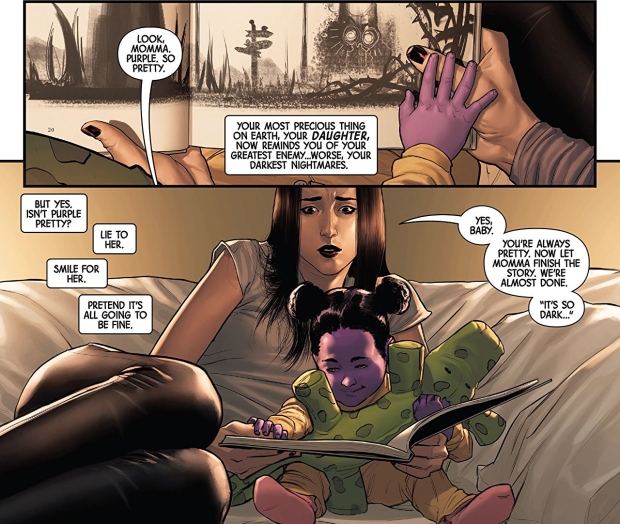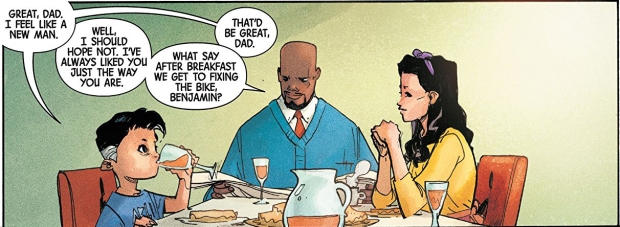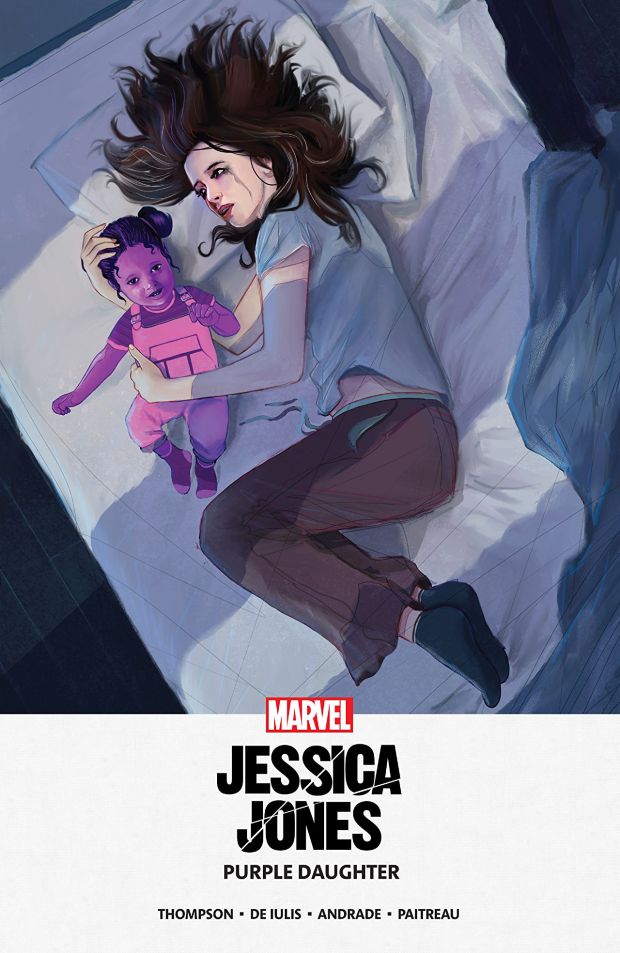by Kelly Thompson, Mattia De Iulis, Felipe Andrade, and Stephanie Paitreau
Collects Jessica Jones: Purple Daughter MDO Digital Comic #1-3
volume one | two
Purple Daughter is a magical combo of two writing pitfalls in superhero books: no one stays dead, and marriage is only interesting when the relationship is threatened.
Jessica spirals into depression and drinking (she makes up for not taking a single shot last volume), when she and Luke find their daughter Dani has turned purple. But after a seemingly final death from Bendis, a controversial, unique and intensely disturbing villain has become an exhausting rehash – god forbid Jessica has a rogue other than the Purple Man! Jessica finally leaves the bar, and also leaves Luke and Dani, to investigate the Purple Problem. It’s fun to see her paired with the newly minted Black King, Emma Frost, and Jessica clearly shines with another badass female character. And I haven’t enjoyed Emma this much in ages.
But truthfully, Jessica’s team up really should have been with Luke.

Back in the last issue of volume one, Luke accidentally buys purple balloons for Dani’s birthday, which triggers Jessica. Luke recognizes that he doesn’t fully understand Jessica’s trauma, and he tells her to be vulnerable with him – so why doesn’t Luke (and Thompson) make good on that promise?
This is, perhaps, the most vulnerable state their relationship could ever be in: Luke and Jessica can’t help but question if their marriage is a lie, if Jessica is still being controlled, if Dani is truly Luke’s daughter…it’s heavy shit. And yet, Jessica doesn’t let Luke investigate with her as she returns to her traumatic past. Luke doesn’t bribe Iron Fist to babysit Dani, and then insist that he not let Jessica do this alone.
Plus, there’s a major plot development at the end that would almost guarantee some significant trust issues and insecurity on both ends, but everything is wrapped up with a nice bow, and somehow the relationship doesn’t change much. Aside from both agreeing about Emma Frost’s boobs, I guess.

Thompson is great at writing heroines (Jessica, Kate Bishop, Elsa Bloodstone), but her villains are often convoluted and far fetched. Kate Bishop’s first villains were a hate cult that used stickers for mind control; in West Coast Avengers, M.O.D.O.K. builds himself a hot bod and zaps women into giant animals. The theme continues in Purple Daughter, with a convoluted, confusing and predictable villain; a hugely surprising, self-violating choice by Jessica that doesn’t seem to leave any emotional scars; and an infuriating escape that still robs Jessica of her peace. (How Jessica doesn’t just move into a therapist’s office is beyond me – though I was actually hoping we’d at least see her visit the support group again.)

The biggest highlight of the book is Mattia De Iulis’ gorgeous art. Everything is clean and sharp, and he uses a combination of blurring and color to show depth and movement. His texturing and shadowing work is also incredible, particularly Jessica’s leather pants and lovely hair detail too. Some of the fighting scenes just crackle on the page and De Iulis’ strong facial expressions really bring characters to life. Even though an artist switch during one issue fit the narrative, Andrade’s style was a bit too rough and unfinished for my liking. Perhaps that’s what the story was going for, but I would have preferred De Iulis use his style more creatively to get the same point across.

There’s no confirmation online, but I believe the series is on hiatus but there’s more Jessica Jones to come (mostly based on this post on De Iulis’ Instagram, which shows some new art). I’m still on board for future issues, Thompson remains one of my favorite writers and De Iulis is fast becoming a favorite artist too…I just hope Purple villains have been put to rest, permanently.











